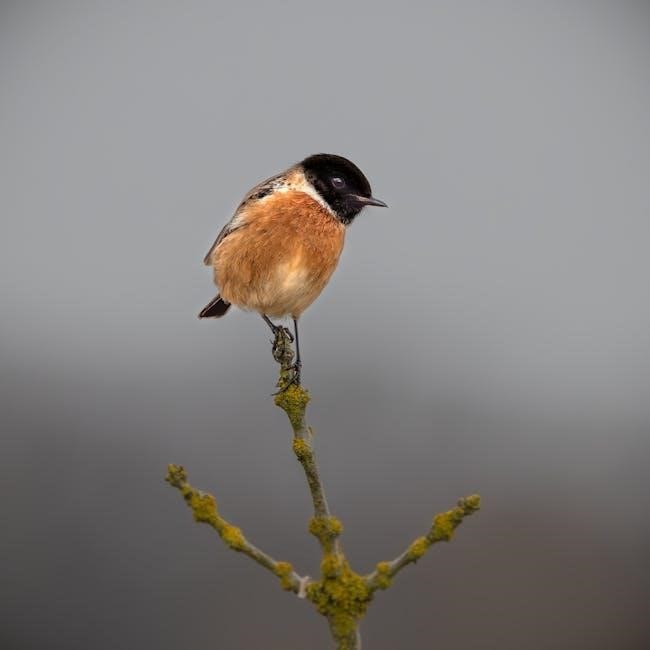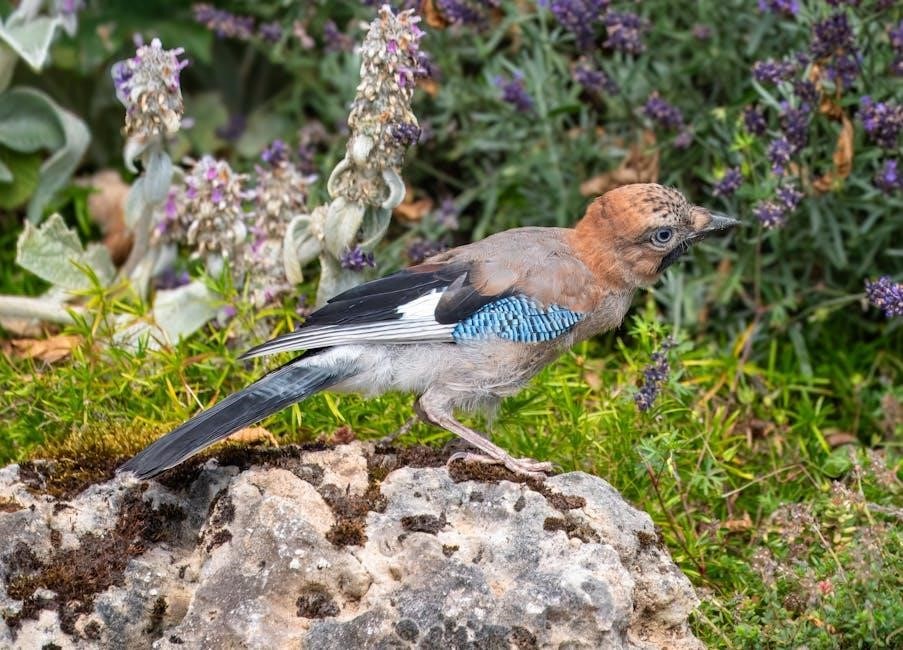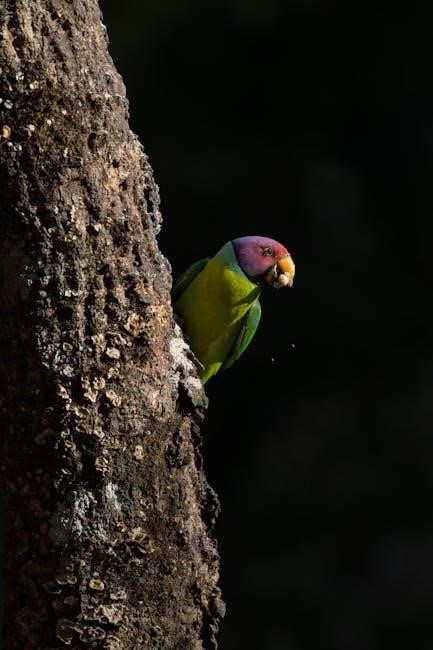Bird nests are incredible engineering marvels, showcasing diverse designs and materials. Each nest is a unique structure, reflecting species-specific adaptations and ecological preferences. They are intricate, functional, and essential for survival, offering insights into avian behavior and habitat needs.
Overview of Bird Nesting Behavior
Bird nesting behavior is a complex and essential aspect of avian life, varying significantly across species. Birds exhibit remarkable diversity in their nesting strategies, from building intricate structures to using pre-existing cavities. The choice of nesting location, materials, and design is influenced by factors such as predator avoidance, climate, and resource availability. Some species construct nests in trees, while others prefer ground-level sites or burrows. The nesting process often involves careful selection of materials like twigs, grasses, and feathers, which are arranged to provide insulation and protection. Additionally, nesting behavior can vary in terms of social structure, with some birds nesting solitarily and others forming colonies. This adaptability highlights the remarkable ingenuity of birds in ensuring the survival of their offspring.
Importance of Nests for Bird Survival
Bird nests are vital for the survival and reproduction of birds, serving as a safe haven for eggs and chicks. Nests protect eggs from predators, harsh weather, and potential damage, ensuring successful incubation. They also provide a stable environment for chicks to grow, regulating temperature and humidity. The structure of nests minimizes risks, such as flooding or predation, and offers insulation, crucial for maintaining optimal conditions for development. Additionally, nests shield chicks from environmental stressors until they are ready to fledge. Without nests, many bird species would struggle to reproduce effectively, making these structures essential for their life cycle and population sustainability. The design and placement of nests are critical adaptations that enhance survival rates and reproductive success in birds.
Materials and Construction Techniques
Bird nests are constructed using a wide variety of materials, including twigs, grasses, leaves, feathers, mud, and even plant fibers or spider webs. The choice of materials often depends on the bird species and its environment. Some nests are intricately woven, while others are simple depressions in the ground. Birds use techniques like shaping, weaving, or packing materials to create structures that are both durable and well-suited to their needs. For example, mound nests rely on decomposing plant material to generate heat, while cup nests are carefully formed to cradle eggs securely. These construction methods not only provide insulation and protection but also help camouflage the nest from predators. The ingenuity in nest-building highlights the remarkable adaptability and resourcefulness of birds in ensuring the survival of their offspring.

Types of Bird Nests
Bird nests vary widely in design, from simple ground nests to intricate cup, platform, and hanging nests, each tailored to specific species’ needs and environments.

Ground Nests
Ground nests are simple structures built directly on the ground, often hidden in vegetation. These nests are typically shallow depressions lined with materials like grasses, leaves, or feathers. They provide insulation and protection from harsh weather, especially in colder climates. Birds using ground nests often have camouflage plumage to avoid predators. However, these nests are vulnerable to flooding and predation. Species like ostriches and some songbirds construct ground nests. Despite their simplicity, ground nests are effective for species adapted to terrestrial environments, offering a safe space for eggs and chicks until they are ready to leave. This nesting strategy highlights the diverse ways birds adapt to their surroundings.

Mound Nests
Mound nests are unique structures built by certain bird species, where eggs are incubated using heat from decomposing plant material. These nests are constructed by layering vegetation, creating a large mound. The male bird typically maintains the nest, regulating temperature by adding or removing material. This method allows for precise control of incubation conditions. Mound nests are notably used by species like the Australian brush-turkey, where higher temperatures can influence the sex ratio of offspring. These nests are an adaptation to environments where traditional nesting methods might be less effective, providing a stable and warm environment for eggs to develop. This strategy eliminates the need for brooding, showcasing a remarkable evolutionary adaptation.
Burrow Nests
Burrow nests are constructed in cavities or tunnels dug into the ground or other materials like sandbars or termite mounds. These nests provide excellent protection from predators and extreme weather. Birds that build burrow nests often line them with soft materials such as feathers or grasses for insulation. The tunnels can vary in depth and structure, depending on the species. This nesting strategy is less common but highly effective for species like kingfishers and puffins. Burrow nests also help regulate humidity and temperature, creating a stable environment for eggs and chicks. The digging skills required to build these nests are specialized, making them a unique adaptation to specific ecological challenges. This method ensures safety and stability for the developing young in a protected underground space.

Cavity Nests
Cavity nests are built within natural or existing openings in tree trunks, branches, or other structures. Birds like woodpeckers excavate their own cavities, while others, such as owls and mallards, use pre-made holes. These nests often have a small entrance leading to a larger chamber inside, which may be lined with materials like moss, feathers, or plant fibers to create a cozy environment. Cavity nests provide excellent protection from predators and harsh weather, and they are often reused in subsequent breeding seasons. Some species also utilize cavities in buildings or utility poles, adapting to human-modified landscapes. This nesting strategy is particularly advantageous for birds seeking sheltered and stable environments for their eggs and chicks. The use of cavities highlights birds’ resourcefulness in selecting safe and suitable locations for raising their young.
Cup Nests
Cup nests are one of the most common types of bird nests, characterized by their cup-like shape. These nests are typically constructed from a variety of materials, including twigs, grasses, leaves, moss, feathers, and even animal hair. The cup shape provides a cozy, protected space for eggs and chicks, while the materials used help regulate temperature and offer insulation. Cup nests are often built in trees, bushes, or on the ground, depending on the species. They are renowned for their intricate design and durability, showcasing the craftsmanship of birds. Some species, like robins, are well-known for their cup nests. The flexibility of these nests allows them to conform to the shape of the bird’s body during incubation, ensuring a snug fit. This type of nest is a testament to the adaptability and resourcefulness of birds in creating safe and comfortable homes for their young.
Platform Nests
Platform nests are large, flat structures built by birds to provide a stable base for their eggs and chicks. These nests are typically constructed from sturdy materials such as twigs, grasses, and vegetation. Unlike cup nests, platform nests are wide and often used by larger bird species like eagles and swans. They are commonly found in trees or on rock outcrops, offering a secure location with minimal predation risk. Platform nests may be reused in subsequent breeding seasons, either by the same bird or different species. This type of nest highlights the birds’ ability to adapt their nesting strategies to their environment, ensuring the safety and survival of their offspring. The durability and size of platform nests make them a remarkable example of avian engineering.
Hanging Nests
Hanging nests are intricately woven structures suspended from tree branches, often crafted by birds in forested areas. These nests are typically small, lightweight, and pouch-like in shape, made from materials such as grasses, leaves, bark, and spider webs. They are usually attached to a single point, providing excellent camouflage and protection from predators. Birds like the baya weaver and certain species of orioles are known for constructing hanging nests. These nests are remarkable for their intricate design, often resembling a bag or a sack. They are well-ventilated and provide insulation, ensuring the eggs and chicks remain safe and comfortable. Hanging nests are a testament to the ingenuity and adaptability of birds, showcasing their ability to thrive in diverse environments. This unique nesting strategy helps protect the young from predators and harsh weather conditions.
Bird nests are true marvels of nature, showcasing incredible diversity and unique strategies for survival. Each nest reflects a species’ ecological needs and ingenuity. Conserving these structures is vital for protecting avian life and their habitats.
Respecting Bird Nests and Their Habitats
Respecting bird nests and their habitats is crucial for avian conservation. Disturbing nests can frighten birds, causing them to abandon their eggs or chicks. It is essential to avoid touching or moving nests, as this can harm the delicate structures and disrupt the nesting process. Additionally, maintaining a safe distance from nesting sites helps protect birds from stress and predators. Preserving natural habitats, such as forests, grasslands, and wetlands, ensures that birds have the resources they need to build and maintain their nests. By respecting these spaces, we contribute to the survival of bird populations and the balance of ecosystems. Supporting conservation efforts and spreading awareness about the importance of nesting habitats can make a significant difference in protecting these incredible creatures.
